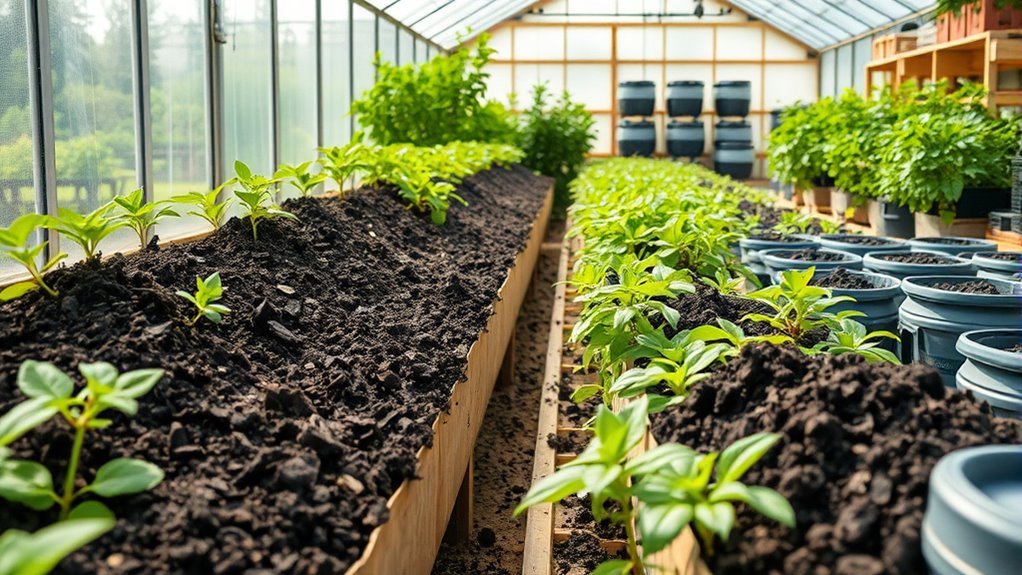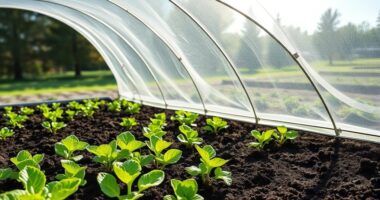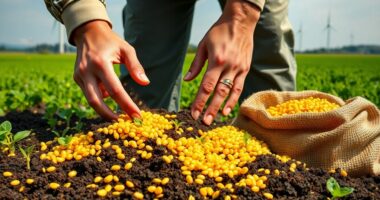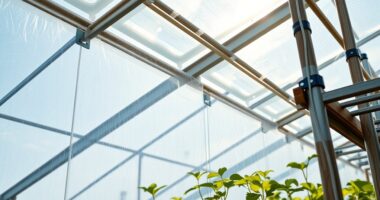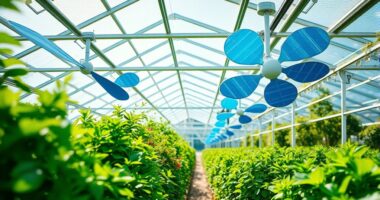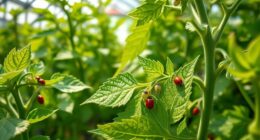To create sustainable soil in your greenhouse, focus on composting organic waste like kitchen scraps, plant debris, and manure to produce rich humus. Use organic fertilizers such as compost and manure to boost soil fertility naturally, helping plants thrive without chemicals. These methods improve soil structure, water retention, and microbial health, making your soil more resilient and self-sustaining. Keep exploring to discover how these practices can transform your greenhouse environment into a healthy, eco-friendly space.
Key Takeaways
- Composting recycles organic waste into nutrient-rich humus that enhances soil fertility and microbial diversity in greenhouses.
- Organic fertilizers derived from compost promote sustainable nutrient release and improve soil structure without chemical dependency.
- Using compost and organic amendments supports soil health, water retention, and pH stability, leading to healthier greenhouse crops.
- Incorporating composting reduces waste, closes nutrient loops, and diminishes environmental impact in greenhouse cultivation.
- Combining composting with mulching and water conservation techniques ensures a resilient, eco-friendly greenhouse ecosystem.
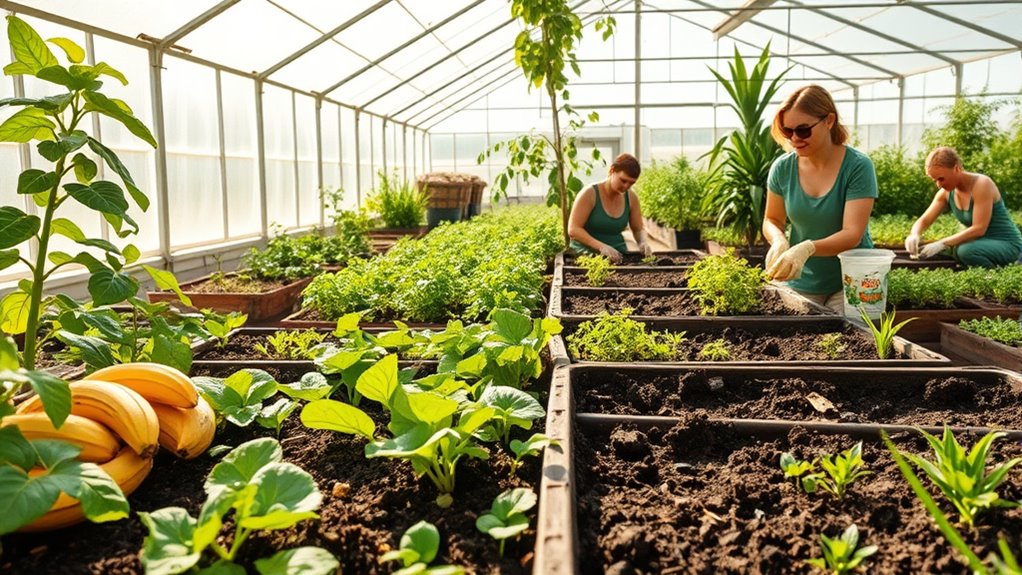
Have you ever wondered how we can protect the ground that grows our food and supports ecosystems? The key lies in maintaining healthy soil, and one of the most effective ways to do this is through the use of organic amendments. These natural materials enrich the soil, boost its fertility, and promote a thriving environment for plants and microorganisms alike. When you focus on improving soil health, you’re not just increasing crop yields; you’re also helping to sustain the entire ecosystem surrounding your greenhouse.
Organic amendments—such as compost, manure, and plant-based materials—play a crucial role in nurturing the soil. Unlike synthetic fertilizers, which can harm soil structure and microbial life, organic amendments feed the soil in a gentle, sustainable way. They introduce essential nutrients gradually, helping plants absorb what they need without the risk of overfeeding or runoff. As you add these amendments, you create a living soil system teeming with beneficial microorganisms that break down organic matter, release nutrients, and suppress pests naturally. This process enhances soil structure, increases water retention, and improves aeration, making your greenhouse environment more resilient and productive.
Composting is a cornerstone of sustainable soil management in greenhouses. When you compost organic waste—kitchen scraps, plant debris, or manure—you recycle nutrients back into the soil, closing the loop in your growing system. Composting not only reduces waste but also produces a rich, dark humus that acts as a powerful organic amendment. By applying compost to your soil, you boost soil health by increasing microbial diversity and building a resilient soil food web. This organic matter improves soil porosity, helping roots penetrate more easily and retain moisture during dry spells. It also buffers pH levels, creating a more stable environment for your plants. Additionally, incorporating water conservation techniques such as mulching can further improve soil moisture retention and overall sustainability.
Using compost and organic amendments together allows you to create a sustainable, self-replenishing soil system within your greenhouse. This approach minimizes dependence on chemical fertilizers, which can degrade soil over time. Instead, you foster a healthy soil ecosystem that naturally supports plant growth, reduces disease pressure, and enhances crop quality. As you continue to add organic amendments like compost, you’re investing in long-term soil vitality, which leads to healthier plants and a more sustainable growing operation. By prioritizing soil health through composting and organic amendments, you take a significant step toward an eco-friendly greenhouse that produces abundant, nutritious crops while protecting the environment.
Frequently Asked Questions
How Does Composting Impact Greenhouse Gas Emissions?
When you compost, you reduce greenhouse gas emissions by lowering your carbon footprint. Proper composting minimizes methane release, a potent greenhouse gas produced when organic waste decomposes anaerobically. By managing compost conditions carefully, you promote aerobic decomposition, which considerably cuts methane emissions. This sustainable practice helps mitigate climate change, and you contribute to a healthier environment by turning waste into valuable organic fertilizer for your greenhouse.
What Are the Best Composting Techniques for Small Greenhouses?
Imagine a miniature compost garden thriving in your greenhouse. You should try worm composting, where worms turn waste into rich fertilizer, or choose a well-designed compost bin that fits your space. Opt for a bin with good aeration and drainage, making composting efficient. These techniques are perfect for small greenhouses, helping you produce organic fertilizer while keeping odors low and maintaining a tidy, sustainable environment.
Are Organic Fertilizers Cost-Effective Compared to Synthetic Options?
When comparing organic fertilizers to synthetic options, you’ll find that the cost comparison often favors organics in the long run. Organic fertilizers usually have lower fertilizer pricing, especially if you produce your own compost, reducing expenses. While initial costs might be higher, their sustainability and soil health benefits make them cost-effective over time. Plus, using organic fertilizers minimizes environmental impact, making them a smart choice for budget-conscious growers.
How Often Should Organic Fertilizers Be Applied in Greenhouse Settings?
You should apply organic fertilizers based on your plants’ needs and growth stage, typically every 2-4 weeks. The application frequency depends on factors like crop type, soil condition, and fertilizer type. Adjust your fertilizer timing accordingly to avoid over- or under-fertilizing. Regular monitoring of plant health helps determine the right schedule, ensuring ideal growth and nutrient uptake while maintaining sustainable practices in your greenhouse.
What Pests Are Attracted to Compost in Greenhouses?
Just like the sirens of myth, compost pests can lure unwanted trouble into your greenhouse. Compost pests such as fruit flies, fungus gnats, and certain beetles are attracted to the rich organic material, making your compost a hotspot for greenhouse attraction. These pests thrive on moist, decomposing matter, so regular monitoring and proper compost management keep them at bay. Stay vigilant to protect your plants and maintain a healthy environment.
Conclusion
By embracing composting and organic fertilizers, you’re gently guiding your greenhouse toward a more harmonious future. These practices nurture your soil softly, ensuring it remains resilient and vibrant without over-reliance on harsh chemicals. While the journey may seem subtle at first, the long-term benefits quietly weave a sustainable tapestry beneath your plants. Remember, small mindful choices today can subtly shift the balance, cultivating a greener, more resilient tomorrow for your greenhouse and beyond.
